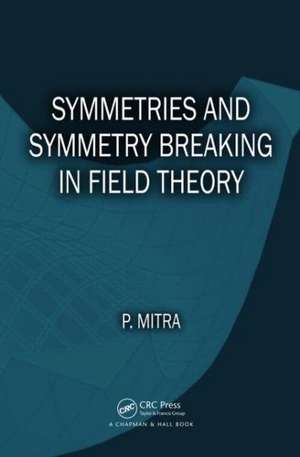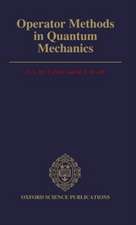Symmetries and Symmetry Breaking in Field Theory
Autor Parthasarathi Mitraen Limba Engleză Hardback – 14 mai 2014
The book presents a broad selection of important topics, including constraint theory, generalized Pauli–Villars regularization, the measure approach to anomalies, zeta function regularization, and anomalous gauge theories. The author explains how some classical symmetries are broken by anomalies and how other symmetries of the theory are spontaneously broken. He discusses all of the ideas in as simple a way as possible.
| Toate formatele și edițiile | Preț | Express |
|---|---|---|
| Paperback (1) | 478.95 lei 6-8 săpt. | |
| CRC Press – 5 sep 2019 | 478.95 lei 6-8 săpt. | |
| Hardback (1) | 778.51 lei 6-8 săpt. | |
| CRC Press – 14 mai 2014 | 778.51 lei 6-8 săpt. |
Preț: 778.51 lei
Preț vechi: 949.40 lei
-18% Nou
Puncte Express: 1168
Preț estimativ în valută:
148.99€ • 154.97$ • 122.100£
148.99€ • 154.97$ • 122.100£
Carte tipărită la comandă
Livrare economică 15-29 aprilie
Preluare comenzi: 021 569.72.76
Specificații
ISBN-13: 9781466581043
ISBN-10: 1466581042
Pagini: 112
Ilustrații: 2 black & white illustrations, 2 black & white tables
Dimensiuni: 156 x 234 x 13 mm
Greutate: 0.34 kg
Ediția:1
Editura: CRC Press
Colecția CRC Press
ISBN-10: 1466581042
Pagini: 112
Ilustrații: 2 black & white illustrations, 2 black & white tables
Dimensiuni: 156 x 234 x 13 mm
Greutate: 0.34 kg
Ediția:1
Editura: CRC Press
Colecția CRC Press
Cuprins
Introduction. Elements of Classical Field Theory. Global Symmetries. Local Symmetry and Constraint Theory. Functional Integral Formulation of Field Theory. Nonabelian Gauge Symmetry. Discrete Symmetries. Spontaneous Symmetry Breaking. Breaking of Chiral Symmetry on Quantization: The Anomaly. Index.
Descriere
This book sheds light on various aspects of symmetry in field theory, including constraint theory, generalized Pauli–Villars regularization, the measure approach to anomalies, zeta function regularization, and anomalous gauge theories. Unlike most field theory books, this one uses constraint theory in discussing gauge theories. The author explains how some classical symmetries are broken by anomalies and how other symmetries of the theory are spontaneously broken. He discusses all of the ideas in as simple a way as possible.















